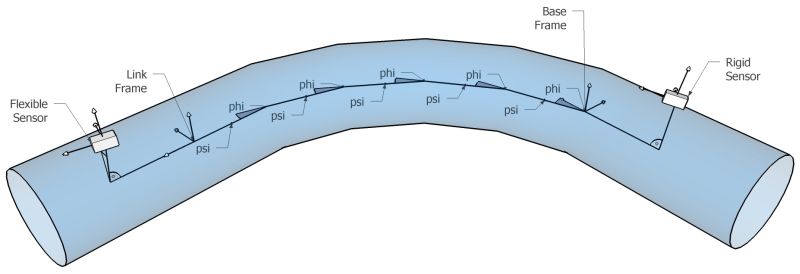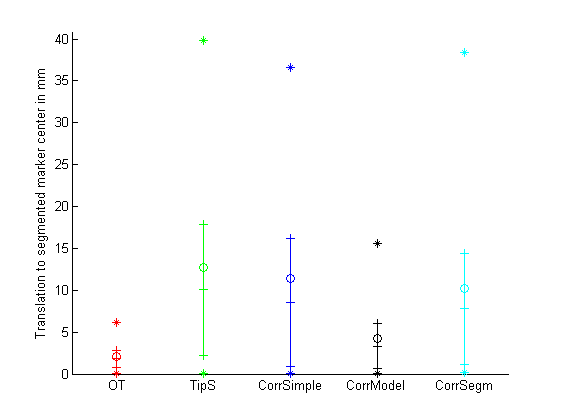Diplomarbeit (DA): Online Error Correction for the Tracking of Laparoscopic Ultrasound
Advisor: Nassir Navab
Supervision by: Marco Feuerstein and Joerg Traub
Abstract
In abdominal surgery, laparoscopic ultrasound is widely used for minimally invasive procedures. Because of the missing visual feedback, it is often difficult for the surgeons to determine the flexible ultrasound transducer's pose, its position and orientation. Utilizing instrument tracking techniques for navigation and augmented visualization can therefore provide great benefits for minimally invasive procedures. Electromagnetical systems are the only currently available means to determine the pose of the transducer tip inside the patient. However, the electromagnetic field can be distorted in various ways, leading to erroneous measurements. Different error correction techniques have been developed, but their application to laparoscopic ultrasound is either difficult or they require an additional calibration procedure before each intervention. Additionally, no techniques have yet been proposed for the compensation of dynamic sources of error. In this thesis two new methods for online error detection and correction for the tracking of flexible laparoscopic ultrasound probes are presented. The first method is hybrid magneto-optic tracking of the ultrasound transducer shaft and electromagnetical tracking of the transducer tip. Deviations between optical and electromagnetical tracking of the transducer shaft are used to estimate the distortion of the electromagnetical field at the transducer tip. The second and more sophisticated method involves a mathematical model of the movements of the flexible transducer tip. All necessary parameters are computed offline in a distortion-free environment and remain valid until the sensors are repositioned. During an intervention the model is fitted to the measurements of the electromagnetical sensor at the transducer tip. Both methods were rigorously tested in experiments and comprehensively evaluated in comparison to related work. Our results are very promising and especially the model based approach improves the current state of art for both error detection and correction.Task
Our laparoscopic ultrasdound transducer features a flexible tip. It can be bent in two directions and is steered by two control levers at the shaft. During an intervention optical tracking cannot be used exclusively, because no direct line of sight can be maintained to the transducer tip inside the patient. We equipped the transducer with two electromagnetical tracking sensors, and attached an optically tracked body to the electromagnetic transmitter. This magneto-optic hybrid tracking allow us to move the transmitter freely and still be able to acquire the sensors' poses in the optical coordinate frame. One problem with electromagnetic tracking is, that the electromagnetic field can be distorted by ferromagnetic materials, like operating room tables or surgical instruments. Various error correction and detection techniques have already been proposed, but either their application to laparoscopic surgery is difficult or they only cover static, i.e. non-moving sources of error. Additionally many techniques require a calibration procedure immediately before each intervention.Methods
We introduce three different approaches for error correction and detection.Sensor Based and Model Based Approach
For error correction and detection we determine, among others, the transformation from the electromagnetical tracking sensor at the shaft to the optical tracking body at the shaft in a distortion-free environment. During an intervention we can then monitor deviations from this pre-determined transformation, and if this deviation gets too high, we may conclude that the tracking of the sensor mounted at the transducer tip is also distorted. Using the deviation, we may also attempt to partially correct the tip sensor measurements by "subtracting" the deviation. For another and more promising approach we designed a mathematical model of all possible movements of the probe tip, i.e. of the tip sensor in relation to the shaft sensor. The model parameters have to be estimated once when the sensors are mounted at the transducer and can then be used without any additional calibration procedure before each intervention. For estimation of the model parameters all reachable poses of the probe tip are recorded and the model parameters are fit to these poses. During an intervention, the model can be optimized for minimal distance to the uncorrected tip sensor pose. Either translation difference, rotation difference or a combination of both can be used. Also the remaining distance between uncorrected sensor measurements and the optimized model can also be used to predict distorted measurements.Segmentation Based Approach
For one possible application, namely the augmentation of laparoscopic video images with live ultrasound data, we may use and additional error correction method. We can automatically extract edges of the ultrasound transducer from the video images of an optically tracked laparoscope and compare them to the magneto-optic tracking data of the transducer tip. We can automatically determine whether we have extracted both edges of the transducer, and if we have, we may compute a correction transformation.Results
Results are very promising, especially for the model based error correction and detection approaches. In a comparative evaluation, the Root Mean Square error of three-dimensional tracking could be reduced from 6.91 mm to 3.15mm, using the model based approach. In other experiments the Root Mean Square error of two-dimensional overlay could be reduced from 12.71 mm to 10.19 mm using the segmentation based approach and to 4.26 mm using the model based approach. The model based and sensor based methods can be combined to achieve even better results. Additionally all necessary parameter determinations can be done offline, so we do not require a calibration procedure before each intervention. The model based error detection method correctly predicted 91% of all errors of 5mm or greater and 93% of all cases where the error was below 5mm. This new method clearly improves the state of art.Documents
| T. Reichl
Online Error Correction for the Tracking of Laparoscopic Ultrasound Diploma Thesis. Technische Universität München, July 2007 (bib) |
Literature
Among others:- Wolfgang Birkfellner et al.: "Systematic distortions in magnetic position digitizers". Medical Physics, 25(11):2242–2248, 1998.
- Dirk Mucha et al.: "Plausibility check for error compensation in electromagnetic navigation in endoscopic sinus surgery". International Journal of Computer Assisted Radiology and Surgery, 1:316–318, 2006.
- Kazuhisa Nakada et al.: "A rapid method for magnetic tracker calibration using a magneto-optic hybrid tracker". Proc. Int’l Conf. Medical Image Computing and Computer Assisted Intervention (MICCAI), 2006.
- Masahiko Nakamoto et al.: "3d ultrasound system using a magneto-optic hybrid tracker for augmented reality visualization in laparoscopic liver surgery". In Proc. Int’l Conf. Medical Image Computing and Computer Assisted Intervention (MICCAI), 2002.
- Yoshinobu Sato et al.: "3d ultrasound image acquisition using a magneto-optic hybrid sensor for laparoscopic surgery". In Proc. Int’l Conf. Medical Image Computing and Computer Assisted Intervention (MICCAI), 2001.
| ProjectForm | |
|---|---|
| Title: | Online Error Correction for the Tracking of Laparoscopic Ultrasound |
| Abstract: | In abdominal surgery, laparoscopic ultrasound is widely used for minimally invasive procedures. Because of the missing visual feedback, it is often difficult for the surgeons to determine the flexible ultrasound transducer's pose, its position and orientation. Utilizing instrument tracking techniques for navigation and augmented visualization can therefore provide great benefits for minimally invasive procedures. Electromagnetical systems are the only currently available means to determine the pose of the transducer tip inside the patient. However, the electromagnetic field can be distorted in various ways, leading to erroneous measurements. Different error correction techniques have been developed, but their application to laparoscopic ultrasound is either difficult or they require an additional calibration procedure before each intervention. Additionally, no techniques have yet been proposed for the compensation of dynamic sources of error. In this thesis two new methods for online error detection and correction for the tracking of flexible laparoscopic ultrasound probes are presented. The first method is hybrid magneto-optic tracking of the ultrasound transducer shaft and electromagnetical tracking of the transducer tip. Deviations between optical and electromagnetical tracking of the transducer shaft are used to estimate the distortion of the electromagnetical field at the transducer tip. The second and more sophisticated method involves a mathematical model of the movements of the flexible transducer tip. All necessary parameters are computed offline in a distortion-free environment and remain valid until the sensors are repositioned. During an intervention the model is fitted to the measurements of the electromagnetical sensor at the transducer tip. Both methods were rigorously tested in experiments and comprehensively evaluated in comparison to related work. Our results are very promising and especially the model based approach improves the current state of art for both error detection and correction. |
| Student: | Tobias Reichl |
| Director: | Nassir Navab |
| Supervisor: | Marco Feuerstein, Joerg Traub |
| Type: | Diploma Thesis |
| Area: | Computer-Aided Surgery |
| Status: | finished |
| Start: | 2007/01/16 |
| Finish: | 2007/07/16 |




